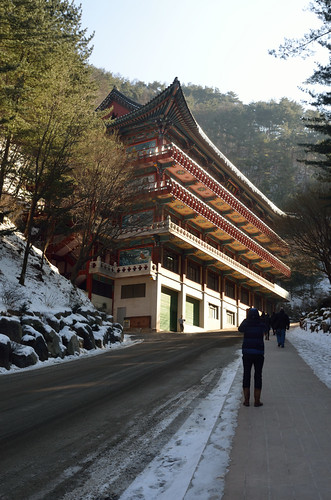A few days ago, I wrote about this lens - Sigma 30mm f/1.4 Nikon mount APS-C lens on full frame camera--Sony A7 @ May 29, 2018
And I talked about second-hand price which was inexpensive. So I will quote that part:
Quite cheaper way to get the f/1.4 lens.
In Korea, secondhand Sigma 30mm f/1.4 EX DC HSM lens was not expensive--about $106 to $130 US dollars, especially Nikon mount. And others like Canon, Alpha mount were more--but not so much.
And secondhand Sigma 30mm f/1.4 for Sony E mount costs around $280.
Other cheap way to get the 1.4 lens is old lens like Takumar 50mm f1.4 or Nikon/Canon 50mm f1.4 which is slightly cheaper than Sigma.
But when put this lens on APS-C camera, it became 75mm lens. Because of crop factor.
According to the Sigma 30mm f/1.4 EX DC HSM lens - Wikipedia web page, on APS-C sensor cameras, its filed of view equivalent to a 46mm lens. Or slightly more for other camera like Canon, older Sigma bodies.
Sigma 30mm f/1.4 EX DC HSM lens technical details:
type: Prime lens
mount type: Canon EF-S, Micro four thrids, Nikon F (DX), Pentax KAF, Sigma SA, Sony/Minolta Alpha
optical design: 7 elements in 7 group
aperture range: f/1.4~f/16
aperture blade: 8
minimum focus: 40 cm
filter thread size: 62mm
weight: 430g
length: 59mm
I don't much care about this technical details of lens. But sometimes it can be useful.
For example, if I already have 62mm uv filter or hood, I can use with this lens.
And I'm walking long hours when I do photo-walks. So if lens wasn't heavy, it was very suitable for me. That is the reason that I mostly shoot with prime lens.
So I do check those things from the technical details.
You can read more about the lens from here:
- Sigma 30mm f/1.4 EX DC HSM Review - Imaging-resource
- Sigma 30mm F1.4 EX DC HSM: Digital Photography Review
- Sigma 30mm F1.4 EX DC HSM Lens Reviews - Sigma Lenses - Pentax Lens Review Database
* You can read user's review and even with sample photos. - Sigma 30mm f/1.4 DC HSM A Lens Review - ephotozine
- Sigma 30mm f/1.4 EX DC HSM Lens Review - the-digital-picture
- Sigma 30mm F/1.4 EX DC review
Sigma 30mm f/1.4 lens with cameras:
 |
| Sigma 30mm f/1.4 lens on Nikon D7000 |
 |
| Sigma 30mm f/1.4 lens on Sony Nex-5R |
 |
| Sigma 30mm f/1.4 lens on Olympus E-P3 |
Photos of the lens that I used.
 |
| Sigma 30mm f/1.4 EX DC HSM for Nikon mount lens |
 |
| Sigma 30mm f/1.4 EX DC HSM for Nikon mount lens |
Technical notes:
These photos were all taken with handheld and I used Nikon G lens to Sony E mount or Micro four thirds adapter so I have no idea about aperture number for the photo.
When I am taking photos, I do use Raw file format. So I need to convert raw file to jpg file and during that time, I do some post-processing--this is kind of darkroom process in developing film.
And when I do this, I don't use any default setting from Rawtherapee--open source software because there has some image modification settings like sharpening, micro-contrast and among other things.
I don't use Adobe Photoshop but this also has same kind of default setting with sharpening.
This isn't important for photography. But this is about the lens--what kind of photo I can take with this lens. So sharpening won't help to know about the lens.
So when I do use Rawtherapee, I removed all the default setting.
I will do these adajustments, if necessary:
- click the auto button in exposure tab--automatically calculate the exposure value,
- adjust exposure value, if overall image was still dark or too bright,
- adjust contrast(between 3 and 18) in L*a*b* adjustments tab,
- if there have some areas were too dark or too bright which makes me feel unbalance the overall look, adjust the shadow/highlight value.
- Sometimes, white balance set to auto or slightly reduce the temperature value. Because Sony A7's white balance value was quite terrible when I do use other brand lens--not Sony E mount lens.
Sample photos:
Nikon D90 with Sigma 30mm f/1.4 EX DC HSM for Nikon mount lens:
 |
| at the Bongeunsa (sa means Buddhist temple) |
Solution for auto focus problem in Nikon DSLR camera.
If you have a Nikon D90 or D7000 and problem with auto focus, you can probably fix with adjust 'Fine tune' in lens setting.
quoted from Autofocus is useless with Nikon D7000 body? | Sigma 30mm f/1.4 EX DC HSM | Flickr
einsteinsmonster said:
I had the same problem with my D7000.
Works perfect on D90.
Fine tuned the lens to -8 and now it's spot on.
Fine tune + or - till your happy with it.
Nex-5R with Sigma 30mm f/1.4 EX DC HSM for Nikon mount lens:
 |
| at Seongnae 2 dong--Bukseongro, Daegu |
 |
| near Dongsingyo, Daegu |
 |
| near Dongsingyo, Daegu |
 |
| at the Sincheongyo, Daegu |
Olympus E-P3 with Sigma 30mm f/1.4 EX DC HSM for Nikon mount lens - Olympus E-P3 has crop factor of x2 so lens became 60mm lens.
 |
| Magpies in a tree. |
 |
| near Sinseonggyo, Daegu |
 |
| at the Sincheongyo, Daegu |
P.S. If you'd like to read in Korean, you can read it from here--this is my Korean blog.





































